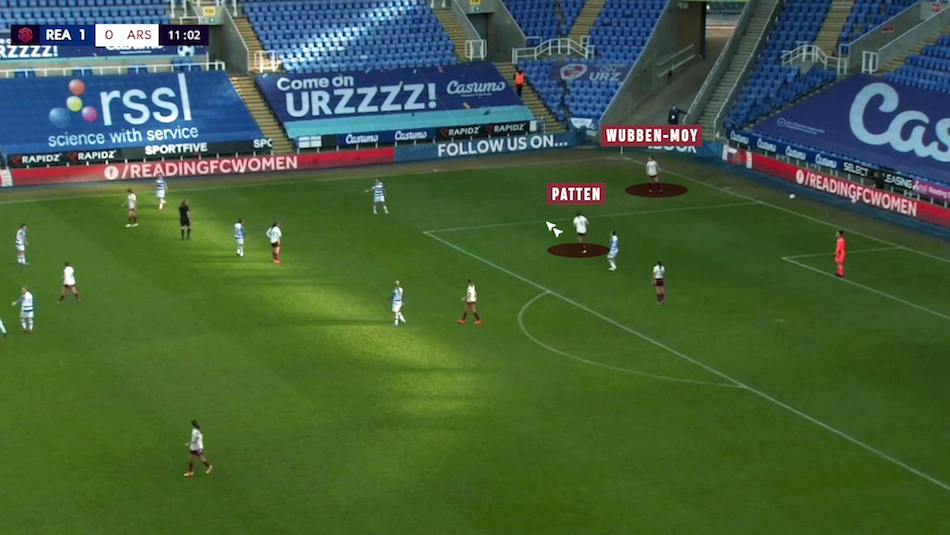Arsenal boss Joe Montemurro opted for the same 3223 formation that he adopted in the reverse fixture against Reading in September. On that occasion, the Gunners ran out 6-1 winners. Though his team selection was influenced by a disrupted training schedule on this occasion with five players having to self-isolate under covid protocols who were unable to train until the middle of last week.
I asked Joe about the thinking behind this system after the game. “They have an overload in midfield because they play with either a diamond or a box so they have an extra player in there. So you need to bypass their first line of press and drag players in so they have to press the ball side and the opposite side is open. We tried that in the first half and it didn’t work so we adjusted things and we got a little bit more joy but all credit to Reading, they pressed us in the right areas and probably showed more belief in what they were doing than us today.”
The tactic worked excellently in September, with Leah Williamson and Lia Wälti in front of the defence, they attracted the Reading press before quickly playing the ball through the lines to the likes of Roord, Nobbs, Little and Mead. Look at Roord’s first goal against Reading in September and look at how quickly she spins in the centre circle to switch play. Arsenal had many opportunities to do something similar on Sunday but too often looked for extra touches or to turn backwards
Arsenal concede an early goal that comes as a result of sloppy play and poor midfield spacing. Arsenal are too narrow with the three centre halves almost within touching distance of one another. Lisa Evans is also in-field because Reading have disjointed the play with a couple of hooked, aerial passes and Malin Gut doesn’t really know where to stand with colleagues attracted in-field.

It leads to a loose pass from Kim Little (and that’s when you know you’re having a bad day). She has too many players too close to her and the wide centre halves have not spread out enough. It means Little’s pass is untidy and leads to a foul being committed by Anna Patten and Reading score from the free-kick.

Patten and Wubben-Moy never really got to grips with their spacing in the back three. Look at this example where they find themselves in the wrong position, with Patten tracking to the centre and Wubben-Moy moving out wide to make a clearance.

Lotte’s clearance is charged down for a throw-in and Wubben-Moy gestures for Patten to move across and take the throw-in as she is the wide centre-half. It was a tough and probably overly complicated system to ask two 21-year old defenders to plug into- especially given that Patten hasn’t played for a few months now. Ultimately, Arsenal’s defence was unable to move the ball quickly through Reading’s press which explains why Beattie and Williamson came on at half-time.

Arsenal could not pass out from the back in the first half. Arsenal have two goal-kicks in succession that illustrate this perfectly. In the first one, Wubben-Moy and Wälti come short, Zinsberger passes to Wälti who finds all of her options closed off and she hits a hopeful pass forwards, which Reading hoover up.


In this clip, after a couple of abortive attempts to pass out, Zinsberger opts to float a longer kick towards the left flank. You can already see the uncertainty with Wubben-Moy waved away over towards the corner of the area while Wlti is right next to the keeper. Again, Reading pounce on the long ball and win possession back.


But most frustrating was Arsenal’s failure to move the ball quickly and exploit gaps in the Reading defence. In this example, Lia Wälti finds Malin Gut with an excellent pass from the back and look at how promising this situation is. Reading’s defence are all near the halfway line and Arsenal have four attackers ready to attack the space.

But Gut takes a poor touch, getting the ball stuck under her foot and Reading snap in to win the ball back and, suddenly, Arsenal have gone from a very promising attacking position to desperately defending their own goal.

In this example, Jill Roord shuffles away from a challenge and finds van de Donk in space. Again, Arsenal have opened up a nice situation here by playing beyond the Reading press and Miedema is looking at plenty of empty space to run into.


But perhaps not checking her shoulder to see Miedema’s run, DvD turns back in-field to play the ball back to Jill Roord who is heavily marked. Reading swarm Roord and win the ball back. Miedema’s frustration is obvious.


Arsenal moved the ball out of their defensive third much quicker when Leah Williamson and Jen Beattie came on at half-time. Lisa Evans lacked full-back support playing wide in front of a back three in the first half, in the second, Lisa switched to right-back and Beth Mead played on the right wing which helped Arsenal sustain some pressure down that flank.
However, Arsenal failed to switch the ball into space on several occasions again. From this free-kick, we can already see Kim Little signaling because she is in so much space with Arsenal dragging the Reading press over to one side of the pitch, as per their plan.

Evans plays the free-kick short to Mead and she takes a couple of touches and Reading quickly close her down. It’s not the easiest pass to switch the ball to Kim but a more confident Arsenal team probably tries the pass to put Reading under pressure.

There was a rare occasion in the 62nd minute when Arsenal did move the ball with a series of one touch passes. Here, Evans goes in-field to Wälti, who knocks the ball first time to Williamson.

All of the Reading players are ball-side, leaving Arsenal’s left flank wide open. Leah moves the ball to Beattie who, in turn, is able to find McCabe in acres of space on the left.

McCabe is able to carry the ball a good forty yards before finding van de Donk in the channel. She finds Little, who puts a dangerous cross into the area that Reading scramble to clear. Switching play quickly was the key to exposing Reading and too often it didn’t happen through a mixture of good Reading pressure and either sloppy passes from Arsenal players, or players taking too many touches before moving the ball on.


Shortly before this Arsenal could have had a similar opportunity to break down their left. Leah Williamson shifts the ball to Lisa Evans at right back, who nudges the ball in-field to Lia Wälti. Reading’s entire midfield four are within striking distance of Lia, if she can just shift the ball to Beattie, McCabe is again in acres of space on the left.

However, uncharacteristically, Lia just allows the ball to run under her foot and with Reading players closing her down, she has little choice but to power it forwards, instead of over to the left where she has teammates in space.

Arsenal did eventually get better at spreading the play but in the closing stages, a tiring Reading team stopped pressing and leaving space, instead settling into a deep block which made them much more difficult to break down. Opportunities were there to open Reading up many times in the opening 75 minutes or so, but too often, caution or sloppiness prevented Arsenal from making the right pass.





Thanks Tim. A frustrating game to watch. Would have been interesting to see if Jordan was playing whether it would have been the same result… Would you say a transfer priority would be finding a CAM who can do what Jordan does? Eg retain possession, complete passes under pressure and move the ball quickly to counter. Roord seems not as able to fill this role despite being preferred over DVD
Arsenal have plenty of mids to fill this role. The team has no continuity what with injuries and other personnel issues. Most of our big rivals put roughly the same team on the field every match while Montemurro changes the lineup, positions and tactics all the time–and seems to enjoy playing 21-year-olds who are clearly not ready for prime time. Why? Since Arsenal won the league title, clearly ManU, ManCity and Chelsea have all got stronger while Arsenal have regressed and lost the chemistry and confidence that they had two years ago. Catley’s lost season has hurt–yet another signing who… Read more »
Rotation isn’t so much of an issue when the tactics are consistent. Younger players are less exposed coming into a team when the tactics are consistent.
Is overthinking also playing a part in us not getting the results as consistently as we’d like?
Cheers Tim. You put a great deal of work into these analyses but you pinpointed Sunday’s problem in one word; Sloppiness! The normal crisp passing moves to feet were not happening which slowed down our movement and gave Reading the chance to rob us of the ball. I don’t think it was a problem with the team selection or tactics on this occasion as discussed at length in your previous post, but the bottom line is if you don’t do the basics well then things don’t go your way. There was not one of our girls who had a decent… Read more »
Tim, perhaps you can explain the logic behind one of the scenarios you describe as it makes no sense to me. We are not the only team to do this but what is the point of drawing an out field player right in to the goalkeeper and then dropping the ball at her feet. This allows the opposition time to run into the area and block any potential pass out when there is already one less player to pass to. In this instance we have Manu and Lia next to one another. Why does Lia need to be that close?… Read more »